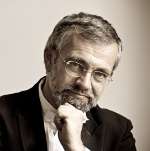Presenting a cello—piano recital of mostly Gallic works spiced up with a contemporary British composition might appear counter-intuitive to most musicians. Not so to Steven Isserlis, who performed an unusual, challenging, inspiring and highly satisfying concert with pianist Connie Shih in Sydney on Monday night, demonstrating a musical collaboration of rare intensity. Seldom does a concert as a whole offer such a range of powerful musical ideas, harmonious with the compositions themselves and equally so with the musicians’ individual artistic abilities and objectives. Isserlis and Shih – representing not only different generations but also cultural backgrounds, countries, even continents – forged a multifaceted partnership that was never less than exciting.
The unity of ideas, the musical conversation (seemingly deceivably effortless) was evident from the first unison bars of the Sonata no. 1 in C minor by Camille Saint-Saëns. The slow movement’s gentle legato theme in the cello was perfectly balanced with the piano left hand’s furtive staccatos and when, a few bars later, the two instruments swapped parts, Shih somehow succeeded in playing the theme with the same introverted suppleness, despite the fact that she had to play five or more accompanying notes for each notes of the melody. Much of the last movement’s storm is implied only in the score; barking cello sounds or longer melodies are constantly under the threat of the continuous flow of barely audible, rapid and menacing piano passages until the coda when thunder and lightning finally takes over in victorious fortissimo.
Saint-Saëns was a teacher and friend of Gabriel Fauré, thus it was only fitting that the latter’s Cello Sonata no. 2 in G minor followed. Aptly, it started with the same fervent energy (again driven from the relentless current in the piano part) with which the Saint-Saëns sonata finished. The never-ceasing passion and energy in this late work of the nearly completely deaf septuagenarian is as admirable as it is undeniable, notwithstanding the fact that the sonata’s musical language must have sounded anachronistically old-fashioned the day when it was finished in 1921. Isserlis has been a passionate advocate for the merits of Fauré’s chamber music output. Even if the composition may not have convinced everyone in the audience, the performance certainly did.
Isserlis and Shih also presented an Australian première on this tour: Lieux retrouvés (or Rediscovered Places, a reference to Marcel Proust’s Le temps retrouvé), Thomas Adès’ present-day take on a “cello sonata” in all but the name. Its four movements are titled The Waters, The Mountains, The Fields and The City in French. The structure of the composition and the strong characteristics of the individual movements are not in need of these nominal references, for the movements nonchalantly, almost as if by accident follow the basic form of a classical sonata: Opening movement – Scherzo – Slow movement – Finale. Lieux retrouvés is an intelligently constructed work with formidable technical demands on both players, yet at the same time audaciously filled with emotions. In our post-modernist era, this is not a commitment to be taken lightly. The subdued serenity of the slow movement (Les champs) impressed me as – dare I say? – the most beautiful music that I so far experienced in our century’s output, aided by sublime pianissimo and complete bow control from Isserlis and velvety, yet resonant comments from Shih.
Although César Franck was Belgian by birth, he is often thought of as a Frenchman as he lived most of his life in Paris. The transcription of his Violin Sonata into Cello Sonata in A major (the last item in the concert) was prepared by the cellist Jules Delsart and sanctioned by the composer. Unlike many similar 19th century transcriptions, this sonata works remarkably well on the cello (though some violinists with purist inclinations would only reluctantly concede to this), and the concessions to the lower register of the cello were further diminished by Isserlis who played several passages up an octave.
The understated grandeur of this performance was exemplary. Every note led onto the next one with purpose, every chord in the piano was played with relevance and there were no balance problems. This would have been impossible with a lesser pianist than Connie Shih. Isserlis’ firm belief in the expressive sound and beauty of gut strings wound with metal (most of his colleagues play on steel core strings wrapped in tungsten, silver and even titanium) has one disadvantage: a diminished range of the louder dynamics. Evidently, this means a certain restriction on how his pianist partner can use the broad dynamic possibilities of the mighty Steinway piano. This was hardly ever a problem in the slower passages – the Franck sonata’s third movement excelled in its transparent, ethereal simplicity – but it did make some faster, busier sections of the piano part (for example the middle section or the coda of the second movement) harder to appreciate, and at times nearly inaudible as a result of Shih’s efforts never to cover the cello sound.


